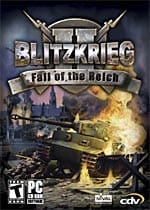Blitzkrieg 2 in a new package
Blitzkreig 2 was a great game that was at the top of everyone’s list, but it’s doubtful if this expansion pack would even make Schindler’s list.
Thanks to computer games, WWII has lasted longer than Gilligan’s Island has been in syndication.
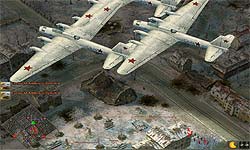
Blitzkrieg 2: Fall of the Reich is the stand-along expansion pack to Blitzkrieg 2, which was released in 2005. It treads familiar ground, and as a result doesn’t take us anywhere new both figuratively and literally. The graphics haven’t been upgraded, and the missions are less varied. What you can expect is a more difficult game. Whereas Blitzkrieg 2 was relatively easy, it was engaging and entertaining. In an effort to compete with the glut of WWII games out there, the developers felt it necessary to provide fans with more of a challenge. While I applaud the resistance to pad the gameplay with complicated and annoying micromanagement, the ramped-up difficulty is certain to alienate novices. Even on the easiest setting you’ll have quite a struggle on your hands, but not what I would necessarily call a challenge.
The focus of the gameplay is tighter and more refined than it was in the original, but unfortunately it’s also one of the game’s biggest disappointments. There was a freshness to the original that I attribute to the variety of missions. Locations differed wildly in terrain and weather conditions; from scorching deserts to frozen Russian wastelands. In this expansion pack, the fighting is confined to the Eastern front, over 10 different maps. The maps are large but the lack of diversity in terrain and gameplay strategy has the opposite intended effect, making them long and tedious. The campaigns include historic battles such as the Siege of Budapest and the Russians’ Operation Bagration. The tone is more serious and less fun. It’s as though we’ve been taken out of the mailroom which was filled with our zany friends and thrust into tiny cubicles on the main floor where we are introduced to such foreign corporate concepts such as “responsibility” and “discipline.”
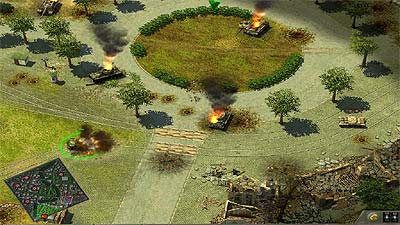
If you’re up for the challenge, Blitzkrieg 2: Fall of the Reich, will give you a good workout, but there is more trial and error to these campaigns than I feel comfortable with. Sure, I lost quite a few battles, but even when I did finally complete them, I was still unable to see how I could have made the perfect decision based on the available information. I know that not everything is cut and dried in a war but some of these campaigns hinge on having one or two specific elements in place from the outset, and the only way you’ll win most of the battles the first time around is to get lucky.
You can call for reinforcements, but you’re limited to the number of units that you start the campaign off with. You can’t create any more. The units aren’t very responsive and if they’re not in the right place at the right time, they are unlikely to arrive in time to prevent a full-blown assault. The enemy always seems to sense where you’re weak, but due to the dreaded fog of war, you’ll just have to guess where their weakness lies. The enemy can even take shots at you while concealed in the fog. Most of the campaigns involve concentrating your units to overcome the enemy at a certain spot. It doesn’t necessarily have to be the weakest spot if you still have most of your units available, because you do have plenty of muscle to bust through their lines. But it’s funny, and unfair, how your enemy seems to always have plenty of reinforcements on hand that are able to show up at a moment’s notice. At least the enemy A.I. doesn’t take full advantage of its apparent upper hand. When they are close enough, they will rush at you kamikaze style, allowing you to pick them off with heavy artillery. At the same time, your A.I. isn’t all that much brighter. You have to issue commands to your units to begin firing even when the enemy is only a few feet away.
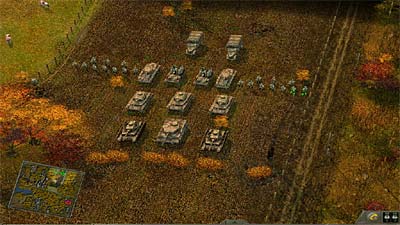
Since this is the final days of the Third Reich, it’s interesting to play as the Germans. You can sense the desperation and utter helplessness as they find themselves surrounded. When you hear those Soviet tanks rolling into your recently captured village, you know the end is neigh. At least you won’t feel too bad about losing these campaigns since you’re just following the natural course of history. Playing as the Russians, you will feel a sense of brutish power, while the Americans display more finesse as they coordinate all of their diverse units into very powerful and concentrated strikes.
Units will have the ability to improve with each successfully completed campaign. These paratroopers, snipers, artillery units, supply trucks, engineers, and aircraft units, will acquire new skills and reinforcements as the sub-commanders of each unit gains experience. If you complete enough missions without losing key units, you will find that the difficulty begins to level out and eventually tip in your favor. It does make things a little too easy at that point. This kind of unbalanced power shift kills the replay value since you will be able to easily figure out how to preserve your favorite units from the get-go.

Online play is available for four players. There are various options that should be considered and discussed among the players first, such as the number of available reinforcements. Failure to take that into consideration will result in one or another player always seemingly having an endless supply of aces in the hole. Online, the game plays just as good as the single-player missions. The menus are easy to access and are very straightforward. Unlike some games, there is virtually no confusion to the commands. If you want to capture a building, there is a command that allows you to do just that, and not “initiate seizure sequence of manufactured dwelling.”
The environments are totally destructible. When a tank unit rolls in to town, trees topple and walls crumble. Bombers help bring the roof down from above. Eventually all that’s left of a town are smoking piles of wood and toppled stones. The graphics are 2D which means that they are capable of processing such grand destruction quickly and accurately. It’s just that the graphics fail to be impressive. They were certainly that with the original, but times are changing and there’s a lot of competition out there that betters this expansion pack considerably, and in 3D to boot. The colors tend to run together and a lot of the buildings share the same basic textures. There is little variation, if any, with any individual soldier or machine in a specific unit. The music is very military but it varies in quality and volume, sometimes getting so loud that it distorts. The sound effects could have more presence. They tend to sound as though you’re listening to them from the same distance that you’re viewing the graphics.
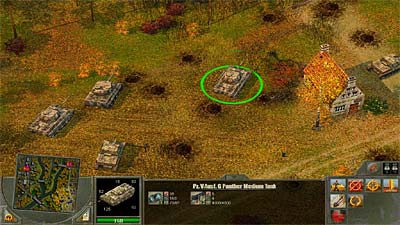
Blitzkrieg 2: Fall of the Reich isn’t likely to gain any new fans for the series. It’s also going to disappoint many ardent fans that were waiting for the “next big thing,” only to find “the same old thing.”
Features:
2.8
Overall Rating – Average
Not an average. See Rating legend above for a final score breakdown.
| Rating out of 5 | Rating Description |
2.8 | Graphics Nothing has been updated from the original. It’s looking dated. |
3.2 | Control The interface couldn’t be easier. Commands are clear and concise. The units are slow to react. |
2.4 | Music / Sound FX / Voice Acting The sounds could be louder. The music varies in quality and volume. |
2.1 | Play Value After you complete a mission in the single-player mode, it’s hard to forget how not to win. |
